How To Paint Shiny Leather In Photoshop Cs6
In this tutorial, I'll testify y'all how to amend your portraits past giving your subject field beautifully shine skin with Photoshop! Nosotros'll start by learning how to remove pimples and other pocket-size skin blemishes using Photoshop's Spot Healing Brush. And so, later on the initial clean-upwardly, we'll larn step-by-step how to shine and soften skin without blurring of import details, like the person'due south eyes, hair and then on, and while keeping as much good skin texture as possible.
To follow forth, you tin employ any portrait photo. I'll use this image that I downloaded from Adobe Stock:

The original image. Photograph credit: Adobe Stock.
Hither'south a close-up of what the immature adult female'due south pare looks like initially:
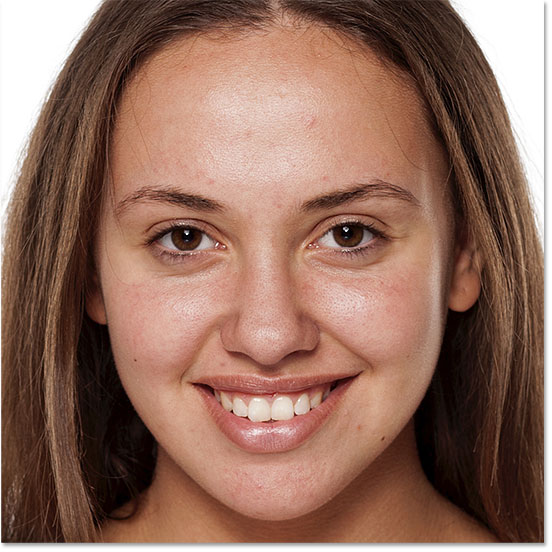
A close-up of the original.
And hither's what she'll look like later smoothing and softening her skin:
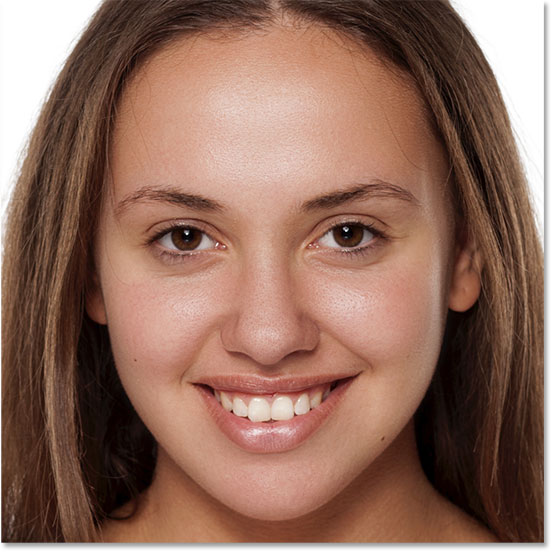
The final peel-softened result.
Allow'due south get started!
How To Smoothen Skin In Photoshop
I'm using Photoshop CC but this tutorial is fully compatible with Photoshop CS6 and earlier.
Step 1: Make A Copy Of The Image
With the image newly-opened in Photoshop, the Layers panel shows the photo on the Background layer. Before smoothing the peel, start by removing any unwanted blemishes. To protect the original epitome, you'll want to work on a separate layer. Brand a re-create of the Background layer by pressing and holding the Alt (Win) / Option (Mac) key on your keyboard, clicking on the Background layer, and dragging it downwards onto the New Layer icon at the bottom of the Layers panel:
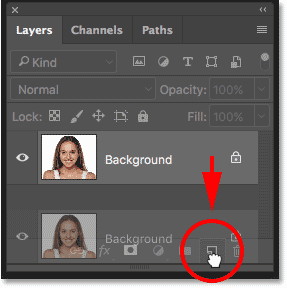
Duplicating the Groundwork layer.
In the Duplicate Layer dialog box, name the layer "Spot Healing" and and then click OK:
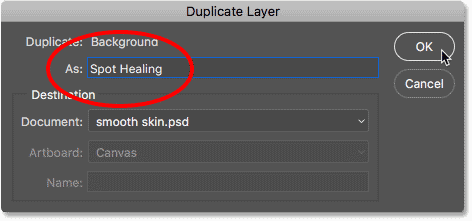
Naming the layer "Spot Healing".
A copy of the paradigm appears on a new layer named "Spot Healing" higher up the original:
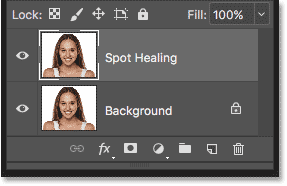
The initial pare cleanup volition now be done on a separate layer.
Step two: Select The Spot Healing Brush
Select the Spot Healing Brush from the Toolbar:

Selecting the Spot Healing Castor.
Step three: Set The Spot Healing Castor To "Content-Aware"
Make certain the Type option in the Options Bar is prepare to Content-Aware:

Content-Aware should be selected past default.
Stride 4: Click On The Skin Blemishes To Remove Them
Click on whatsoever unwanted pare blemishes with the Spot Healing Brush to remove them. Photoshop will instantly "heal" the blemishes by replacing the trouble texture with good skin texture from the surrounding area. For best results, brand your brush slightly larger than the blotch. To change your brush size, press the right bracket cardinal ( ] ) on your keyboard to make the castor larger or the left bracket key ( [ ) to make it smaller. If the blemish hasn't completely gone away on the first try, undo your click by pressing Ctrl+Z (Win) / Control+Z (Mac) on your keyboard, and so resize your brush if needed and click on the same blemish to try once more.
Example: Removing Skin Blemishes With The Spot Healing Brush
If nosotros expect at the woman's forehead in my image, we see what looks like a large pimple simply to the correct of center. I'll position the Spot Healing Brush over it, and I'll make my brush slightly larger than the pimple itself:
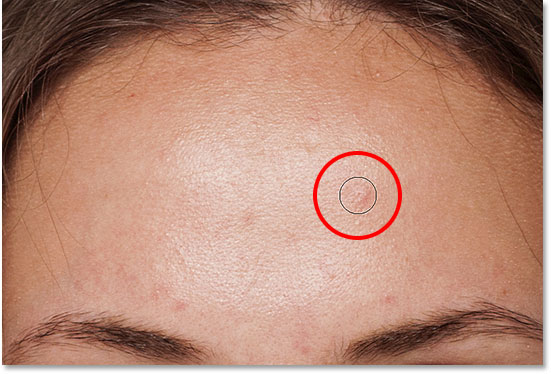
Positioning the Spot Healing Brush over a skin blemish.
To remove the blemish, I'll click on information technology with the Spot Healing Brush. Photoshop analyzes the area I clicked on, finds expert skin texture from the area surrounding it, and then blends the practiced texture in with the problem area's original tone and color. Like magic, the blemish is gone:
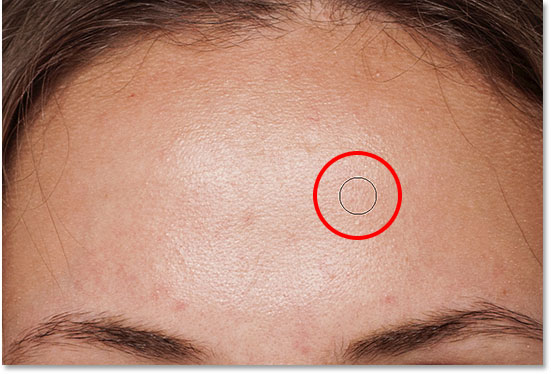
Clicking to heal the blemish.
I'll practice the same thing with another blemish on her brow, keeping the Spot Healing Brush just a flake larger than the area I need to heal:
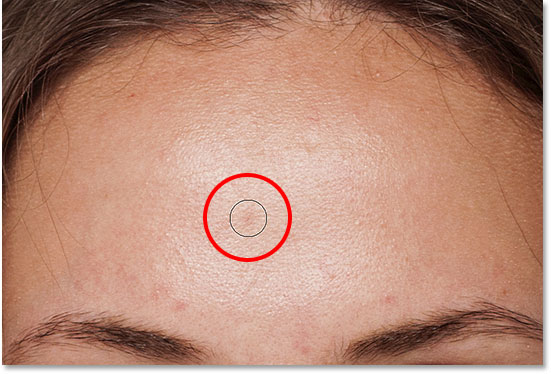
Positioning the Spot Healing Brush over a second blemish.
I'll click on the blemish, and in one case over again, Photoshop instantly removes it:
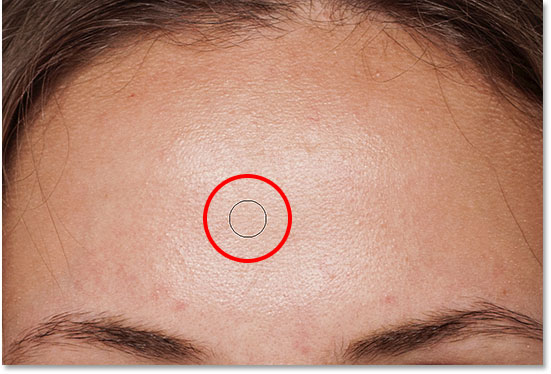
The second blotch is gone.
After a few more than clicks with the Spot Healing Brush to clean upward the remaining blemishes on her forehead, her skin is already looking much smoother:
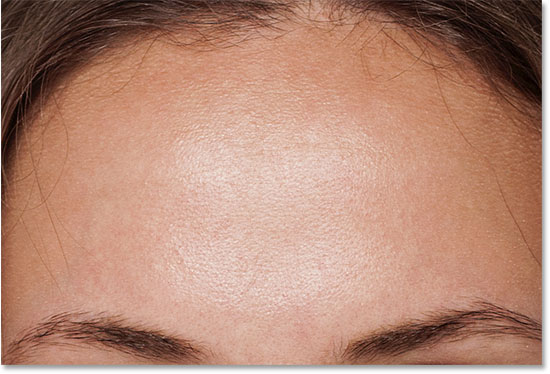
The blemishes have been removed from her brow.
Removing Blemishes, Non Features
As yous're retouching the skin, keep in mind that while it's okay to remove temporary issues like acne or other minor skin issues, it'south commonly not okay to remove permanent features like moles or even certain scars, as these are part of what makes someone who they are. After all, the goal of epitome retouching is to help people look their best, not to make them expect like someone else.
Completing The Initial Peel Cleanup
Continue working your mode around the person's face to remove any remaining blemishes. Here's a side-past-side comparing of what the woman's skin looked like originally (left) and after some quick retouching with the Spot Healing Brush (right). With almost photos, this initial skin cleanup should take no more than a few minutes. I covered the Spot Healing Brush rapidly here, but you tin learn more about it in my Removing Acne, Skin Blemishes With The Spot Healing Brush tutorial:
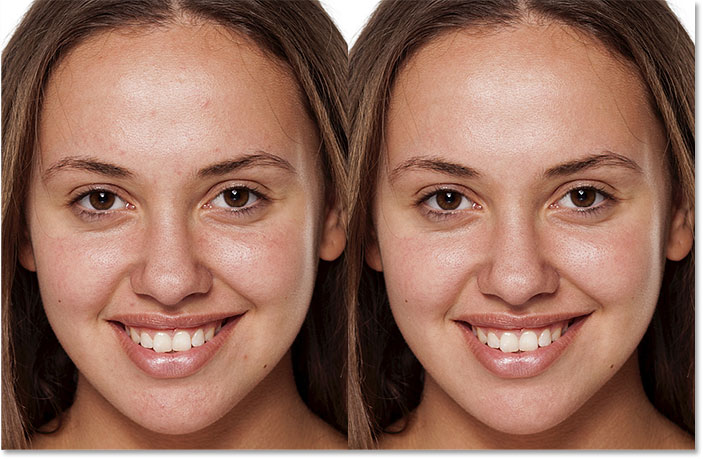
A before (left) and afterward (right) comparison of the initial skin retouching.
Step five: Make A Copy Of The "Spot Healing" Layer
With the blemishes removed, we're gear up to smooth and soften the skin, and again, information technology'due south all-time to work on a split layer. Back in the Layers panel, make a re-create of the "Spot Healing" layer by pressing and holding the Alt (Win) / Pick (Mac) key on your keyboard, clicking on the "Spot Healing" layer, and dragging it down onto the New Layer icon:
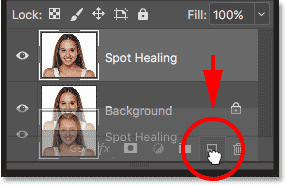
Duplicating the "Spot Healing" layer.
In the Indistinguishable Layer dialog box, proper name the layer "Smooth Skin" and then click OK:
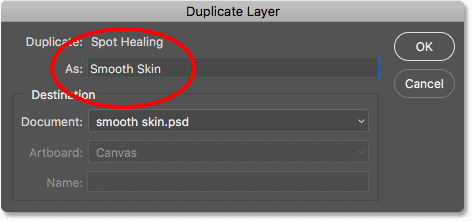
Naming the duplicate layer "Smooth Pare".
We now have the original image on the Groundwork layer, the initial skin cleanup on the "Spot Healing" layer, and a new "Smooth Skin" layer to a higher place them:
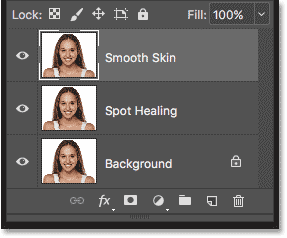
The "Shine Skin" layer appears to a higher place the "Spot Healing" layer.
Step six: Employ The High Pass Filter
To shine the skin, nosotros'll apply Photoshop's High Pass filter. Go up to the Filter carte du jour in the Menu Bar, choose Other, and then choose High Pass:
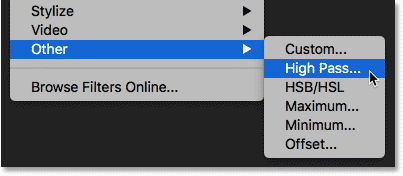
Going to Filter > Other > Loftier Pass.
Why The Loftier Pass Filter Is Great For Smoothing Skin
If you're familiar with the High Laissez passer filter, it's about likely considering y'all've used it to sharpen images in Photoshop. Even though we'll be using High Pass to smooth skin, not acuminate information technology, many of the steps are the same. The High Pass filter looks for edges in the paradigm and highlights them. An border is an area where there's a big, sudden alter in brightness or colour between neighboring pixels. With portrait photos, the edges are commonly along the person's hair, effectually the eyes, the oral cavity, and and then on. Skin texture, on the other manus, has relatively low amounts of particular with much smoother transitions. These areas are not considered an edge, so rather than highlighting them, the High Pass filter fills these areas with neutral gray.
If we were sharpening the image, the High Pass filter would allow us to sharpen the edges (the details) without affecting the skin. Merely for smoothing skin, we utilize High Laissez passer for the reverse reason. Nosotros'll notice the edges not so nosotros can sharpen them merely so nosotros can smooth and soften everything except the edges. Allow's run into how it works.
The Radius Value
The High Pass filter detects edges and highlights them, and the Radius pick at the bottom of the High Laissez passer dialog box controls the "thickness" of the edge highlighting. In other words, once Photoshop has detected an edge, the Radius value tells it how many pixels on either side of it to include equally part of the border. Low Radius values volition highlight only the finest details in the image. Only to make certain we don't end up softening these important details, we demand to highlight the areas around them equally well, which ways we need a larger Radius value. For a typical portrait shot, a radius of 24 pixels works well:
Setting the Radius value to 24 pixels.
If your field of study is farther dorsum in the photo, or you're working on a lower resolution image, a smaller Radius value of 18 pixels or even 12 pixels might work better. Why these specific values? Information technology's considering information technology'southward important for the next stride that you choose a Radius value that'southward easily divisible by 3. For case, 24 divided by 3 is 8, 18 divided by three is half-dozen, and 12 divided by 3 is four. Prissy, like shooting fish in a barrel numbers. Over again, we'll see why in the next step.
Click OK to close the High Pass dialog box. Your image will turn mostly gray. Solid areas of grayness are the not-edge areas with lilliputian to no particular, like the peel, while big, high contrast halos highlight the edges:
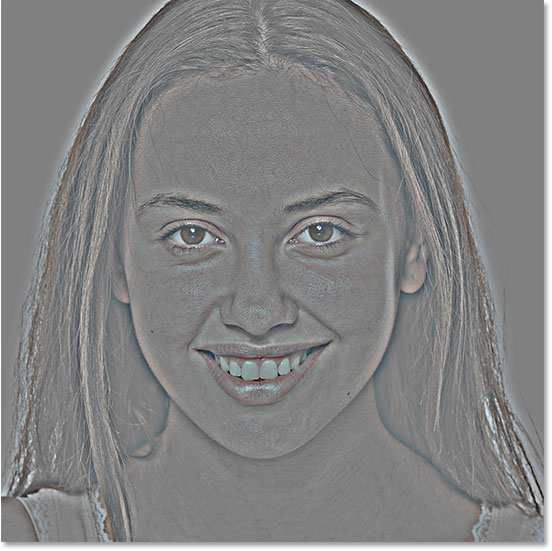
The result afterward applying the High Pass filter.
Footstep 7: Utilise The Gaussian Blur Filter
We need to blur the High Pass filter effect. It may seem counterintuitive, just the blurring will actually assistance to bring out more practiced texture in the skin. Get up to the Filter menu, choose Blur, and and then choose Gaussian Blur:
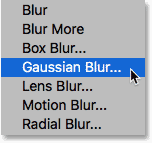
Going to Filter > Mistiness > Gaussian Mistiness.
In the Gaussian Mistiness dialog box, set the Radius value to exactly one tertiary of the value you used for the High Pass filter. In my case, I set the High Pass radius to 24 pixels, so I'll set the Gaussian Blur radius to one 3rd of that, which is viii pixels. Click OK to close the dialog box:
Setting the Gaussian Mistiness radius to one 3rd of the Loftier Pass radius.
With the blurring applied, the High Pass effect now looks softer and less detailed:

The outcome after applying the Gaussian Blur filter.
Step 8: Change The Layer Alloy Manner To Linear Calorie-free
In the Layers panel, change the blend mode of the "Smoothen Skin" layer from Normal to Linear Light:
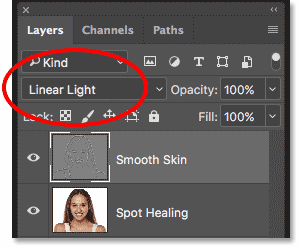
Irresolute the layer blend mode.
This blends the High Pass result in with the image, creating a high contrast, over-sharpened issue. Information technology may look terrible, simply don't worry. Information technology will wait even worse in a moment:
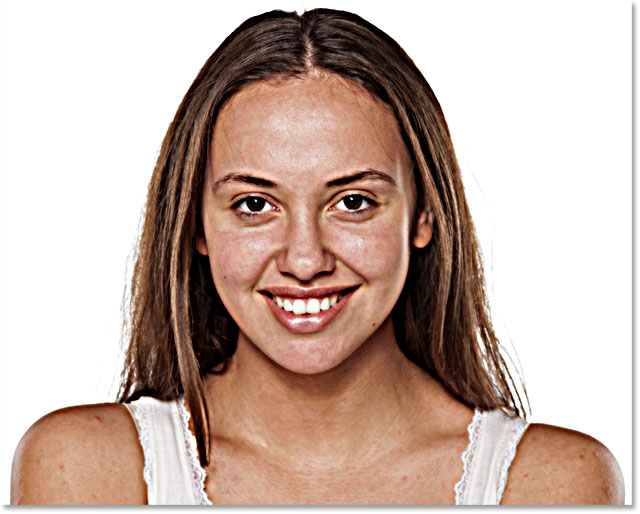
The epitome later changing the Polish Pare layer's alloy way to Linear Light.
Related: Photoshop's 5 Essential Alloy Modes For Photo Editing
Step 9: Invert The Layer
Go upward to the Image menu, cull Adjustments, and and then choose Invert:
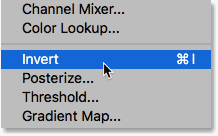
Going to Image > Adjustments > Capsize.
With the layer inverted, the epitome goes from existence over-sharpened to looking like a weird, blurry mess with large ugly halos around everything:
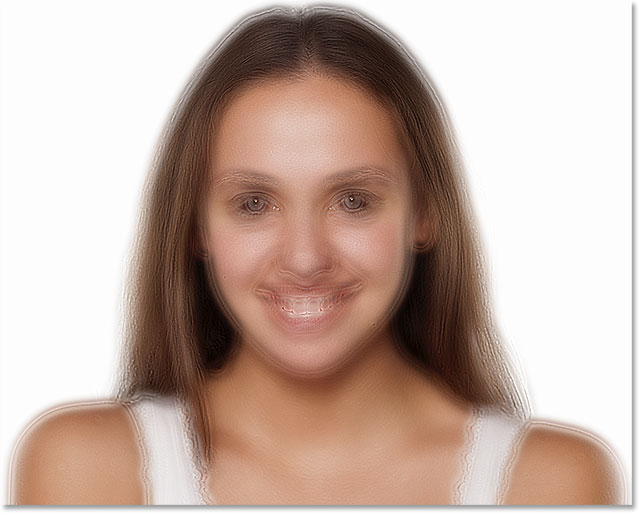
The result after inverting the "Smooth Skin" layer.
Step x: Open up The Blending Options
To reduce the halo issue, click the Layer Styles icon at the bottom of the Layers panel:
Clicking the Layer Styles icon.
Choose Blending Options from the top of the listing:
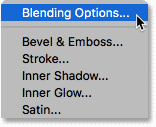
Opening the Blending Options.
Step xi: Drag The "Blend If" Sliders
In the Layer Way dialog box, wait for the Alloy If sliders at the bottom. There are two sets of sliders, one labeled "This Layer" and ane below it labeled "Underlying Layer". Nosotros need the top sliders (the ones labeled "This Layer"):
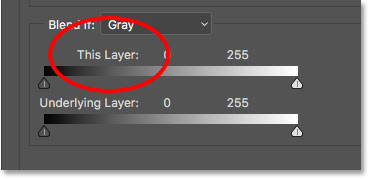
The Blend If sliders.
Discover the slider below each end of the gradient bar. These sliders command how the "Smooth Peel" layer blends with the image below it based on the brightness levels of the layer. The slider on the left is used to alloy the darker areas of the layer and the slider on the right blends the lighter areas:
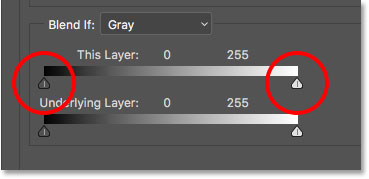
The dark (left) and calorie-free (right) sliders.
Reducing The Calorie-free Halos
Starting time by reducing the lighter halos. Printing and concur the Alt (Win) / Option (Mac) key on your keyboard, click the slider on the right and begin dragging it towards the left. Holding the Alt (Win) / Pick (Mac) fundamental tells Photoshop to split the slider in half so that every bit you're dragging, merely the left side of the slider moves while the correct side stays in place. Watch your image every bit you drag the slider and you'll see the lighter halos fading away. Elevate the slider nearly all the way to the left to reduce them as much equally possible:

Dragging the left half of the slider on the right.
Hither'southward the result after dragging the showtime slider. Most of the lighter halos are now gone, or at least, they're much less noticeable. Only the darker halos remain:
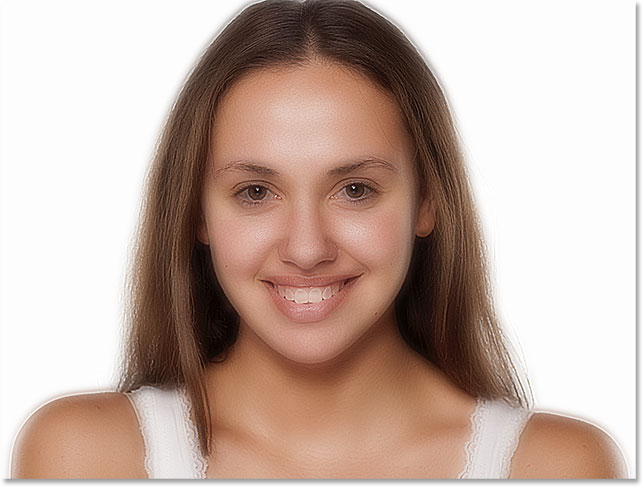
The lighter halos are gone after dragging the slider on the right.
Reducing The Nighttime Halos
To reduce the darker halos, press and hold your Alt (Win) / Pick (Mac) primal, click the slider on the left and elevate the right one-half of it towards the right. Once again, yous'll need to drag almost all the way to the right for most of the dark halos to disappear. Click OK when you're done to close the Layer Style dialog box:
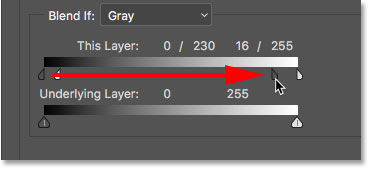
Dragging the right half of the slider on the left.
And here's my image after dragging both sliders. Her skin is looking very polish, but so is everything else in the paradigm. We'll set that next:
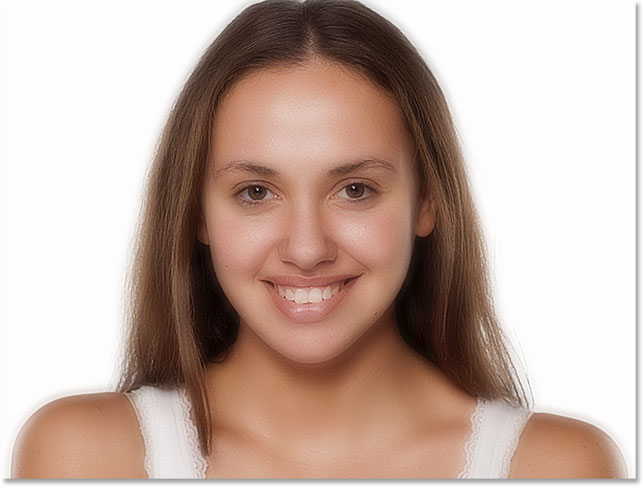
The darker halos are gone later on dragging the slider on the left.
Pace 12: Add A Layer Mask
To limit the smoothing event to simply the peel, add a layer mask. Dorsum in the Layers panel, press and hold the Alt (Win) / Selection (Mac) key on your keyboard and click the Add together Layer Mask icon:
Adding a layer mask while holding Alt (Win) / Option (Mac).
A black-filled layer mask thumbnail appears on the "Smooth Pare" layer. This hides the smoothing effect from view so we can paint it back in but where we need it:
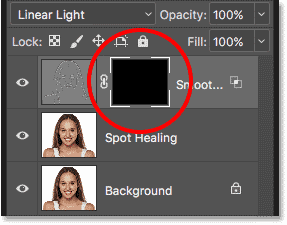
A blackness-filled layer mask has been added to the "Smooth Skin" layer.
Related: Understanding Layer Masks in Photoshop
Step xiii: Select The Brush Tool
Select the Castor Tool from the Toolbar:

Selecting the Brush Tool.
Step xiv: Ready Your Brush Color To White
Brand certain your Foreground color (the brush colour) is prepare to white. You lot tin can encounter your current Foreground and Background colors in the color swatches well-nigh the bottom of the Toolbar. The swatch in the upper left is the Foreground color. If it's not set to white, press the alphabetic character D on your keyboard to quickly reset the colors to their defaults:

The Foreground color (the brush color) should exist white.
Stride xv: Paint Over The Skin
Earlier you lot begin painting, check your brush options in the Options Bar. Make certain that Mode (curt for Blend Mode) is ready to Normal, Opacity is at 100% and Menstruum is as well at 100%:

Making sure the Mode, Opacity and Fill options are all prepare to their defaults.
Then paint over the peel to reveal the smoothing effect. A soft-border castor will work all-time. We already know that we tin change the brush size from the keyboard using the left and right bracket keys. Add the Shift key to modify the brush hardness. Press Shift and the left bracket key to make the brush softer, or Shift and the right bracket key to brand the brush harder.
Example: Painting To Reveal The Smooth Skin
I'll start past painting over her brow. Since we're painting on the layer mask, not on the layer itself, we don't see the brush color as we paint. Instead, we reveal the smoothing upshot in the areas where we've painted:
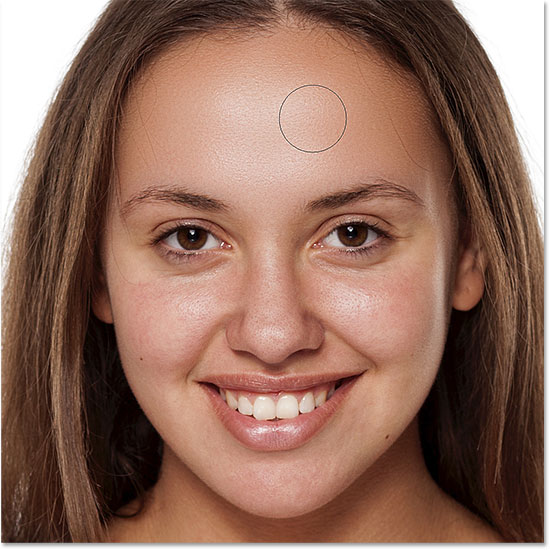
Bringing back the smoothen pare in the adult female'southward forehead.
Adjacent, I'll paint over her nose, her cheeks, and around her eyes to reveal the peel smoothing in those areas. Adjust your brush size as you go to avoid painting over details that should remain sharp. If you practice skid and paint over the wrong area, press the alphabetic character X on your keyboard to prepare your brush colour to black, and and then pigment over the mistake to hibernate the smoothing effect. Press X again to gear up your brush colour dorsum to white and go along painting to smooth and soften the pare:

Revealing more than of the smoothing effect, only but over the peel.
Finally, I'll paint around her oral cavity and over her chin to smooth and soften those areas, while at the aforementioned fourth dimension being careful to avoid her lips:
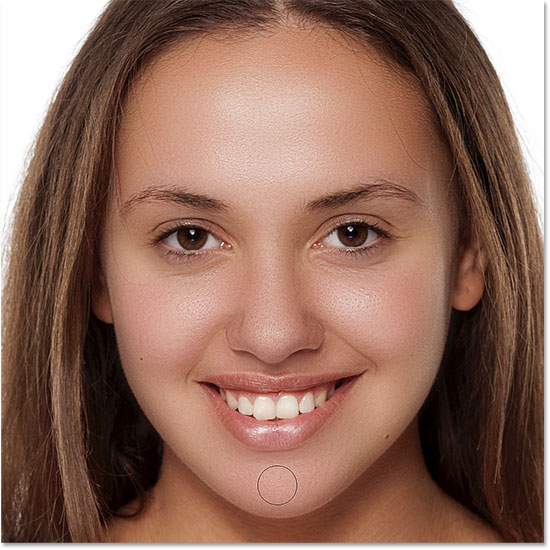
Revealing the smoothen pare in the lower areas of her face.
Viewing The Layer Mask
To see exactly where you've painted, press and hold your Alt (Win) / Option (Mac) key and click on the layer mask thumbnail in the Layers console:
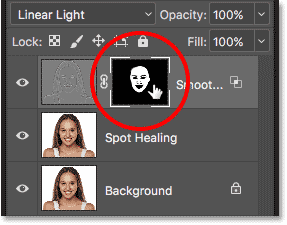
Holding Alt (Win) / Option (Mac) and clicking the layer mask thumbnail.
This switches your view from the epitome to the layer mask. The white areas in the mask are where you've painted to restore the skin smoothing. Black areas are when the smoothing effect remains hidden. It looks a bit creepy, just viewing the mask is a great mode to make certain you lot haven't missed any spots, and you can paint directly on the mask if needed. To switch dorsum to your image, once again printing and hold Alt (Win) / Choice (Mac) and click on the layer mask thumbnail:

Utilise the mask view to await for whatsoever areas you missed.
Footstep sixteen: Lower The Layer Opacity
At this point, nosotros've smoothed and softened the skin, but the effect is too intense. To reduce it, lower the opacity of the "Smoothen Peel" layer. In general, an opacity value of between 40% and 60% works best, but it will depend on your image. I'll prepare mine to fifty%:

Lowering the opacity of the skin softening consequence to l%.
And with that, we're done! Hither, later on lowering the layer opacity, is my terminal result with her skin now looking groovy:

The final skin smoothing effect.
And there we have it! That'south how to easily smooth and soften pare in Photoshop! For more portrait retouching tutorials, learn how to reduce wrinkles, how to change eye color or how to whiten teeth with Photoshop! Or visit our Photograph Retouching section for more tutorials!
Source: https://www.photoshopessentials.com/photo-editing/smooth-skin/
Posted by: bakermorefelied.blogspot.com

0 Response to "How To Paint Shiny Leather In Photoshop Cs6"
Post a Comment